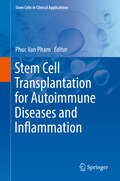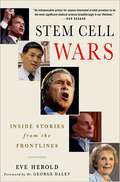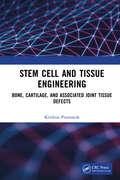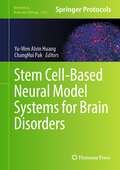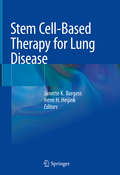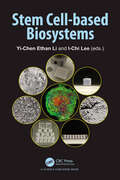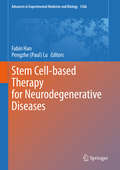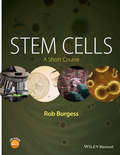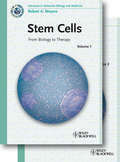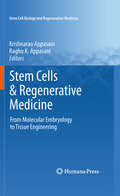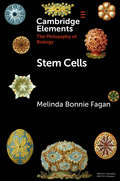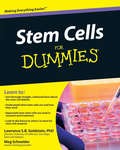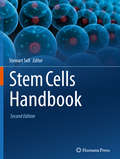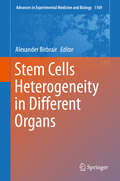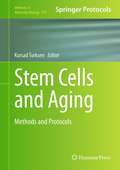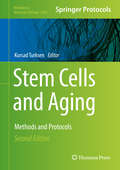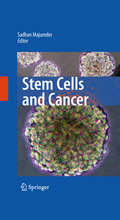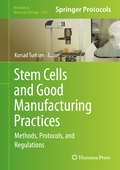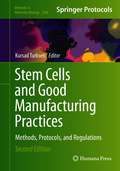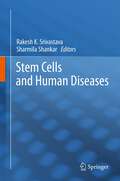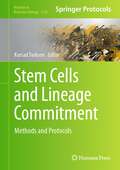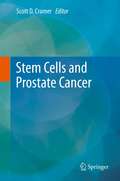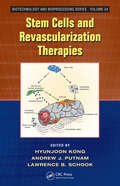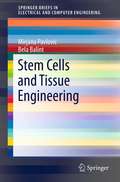- Table View
- List View
Stem Cell Transplantation for Autoimmune Diseases and Inflammation (Stem Cells in Clinical Applications)
by Phuc Van PhamThis book introduces many new technologies and clinical applications of hematopoietic stem cells and mesenchymal stem cell transplantation for the treatment of autoimmune diseases and inflammatory diseases. Presented in two parts, Part 1 focuses on stem cell therapies for autoimmune disease treatment; Part 2 focuses on stem cell therapies and their application in the treatment of common inflammatory diseases, including chronic knee osteoarthritis, chronic obstructive pulmonary disease, liver cirrhosis, Crohn's Disease, Multiple Sclerosis, and more. This book is an essential source for all advanced students and researchers involved with these diseases, stem cells, or both. Stem Cell Transplantation for Autoimmune Diseases and Inflammation and the other books in the Stem Cells in Clinical Applications series are invaluable to scientists, researchers, advanced students and clinicians working in stem cells, regenerative medicine, or tissue engineering as well as cancer or genetics research.
Stem Cell Wars
by Eve Herold George DaleyAmericans have become the victims of misinformation about stem cell research. Over the last few years, the stem cell debate has been intensely political, religious, and confusing to many people. Now, Eve Herold explains what this science is all about, who is for and against it, and why it must go forward. She pulls together fascinating stories to highlight every aspect of this multifaceted field. She exposes the politics of stem cell research and demonstrates how the outcome of the debate could ultimately affect all of us. Packed with real-life stories of the people caught up in this groundbreaking struggle, Stem Cell Wars cuts through the noise and sets the standard for future debate.
Stem Cell and Tissue Engineering: Bone, Cartilage, and Associated Joint Tissue Defects
by Krishna PramanikThis book covers conventional clinical treatment methods for handling bone, cartilage, and related disorders along with their limitations and highlights the current state of the art of tissue engineering as an alternative for regenerating such defective tissue. Potential biomimetic scaffolding materials and their development, desired properties, modifications, and optimizations are described. The design and advancement in fabrication, characterization, properties, and biological functions of scaffolds, their integration with stem cells, and various bioreactor systems for tissue regeneration are presented. It further reviews in vitro and in vivo (pre-clinical) assessments of tissue constructs, involved translational challenges, and strategies in various stages of neo-tissue production.Features: Discusses the key aspects of generating engineered bone, cartilage, and associated tissues through tissue engineering approach Describes multiple engineering principles, and processes involved in the various stages of developing biomaterials and scaffolds Covers integration of stem cells with scaffolds, including assessment of tissue grafts, and translational strategy Explores key factors influencing tissue graft generation in bioreactors and challenges involved in various stages Includes several exercises including review questions and numerical problems for better understanding of the subject This book is aimed at researchers, students, and professionals in biomedical engineering, tissue engineering, stem cells, biomaterials, and orthopaedics.
Stem Cell-Based Neural Model Systems for Brain Disorders (Methods in Molecular Biology #2683)
by Yu-Wen Alvin Huang ChangHui PakThis detailed volume presents validated and well-adapted procedures involving humanized and/or stem cell-based neural model systems that have proven helpful in better understanding the essential brain functions involved in the pathogenesis of brain disorders. The book explores the generation of multiple neural cell types in 2D and 3D as well as cutting-edge techniques to assay neural function. Written for the highly successful Methods in Molecular Biology series, chapters include introductions to their respective topics, lists of the necessary materials and reagents, step-by-step and readily reproducible laboratory protocols, and tips on troubleshooting and avoiding known pitfalls. Authoritative and practical, Stem Cell-Based Neural Model Systems for Brain Disorders serves as an essential resource for researchers and students in neuroscience, stem cell biology, and related fields.
Stem Cell-Based Therapy for Lung Disease
by Janette K. Burgess Irene H. HeijinkThis book presents state-of-the-art pre-clinical models and clinical applications of stem-cell-based therapies applied to different lung diseases, with a special focus on the translation of bench data into clinical studies. Starting with the assumption that abnormal lung tissue repair and regeneration has emerged as the driving force underlying pathogenesis and progression in many lung diseases, it sheds new light on the potential of stem/stromal cells as drivers of repair and sources of reparative factors in the lung. The first part of the book offers an overview of stem cell types and mechanisms involved in lung development, homeostasis, repair and regeneration, and reveals the crucial role of the extracellular matrix within the lung microenvironment. In the second part, leading experts present the latest pre-clinical evidence and clinical applications of stem-cell-based therapies in a wide variety of lung diseases, ranging from COPD and lung fibrosis to other rare lung diseases. The last section discusses stem cell delivery systems and devices, such as aerosolised spray application. This book appeals to pneumologists, stem cell and matrix biologists, as well as bioengeneers with a special interest in regenerative medicine applied to pulmonary diseases.
Stem Cell-based Biosystems
by Yi-Chen Ethan Li I-Chi LeeStem cell science has emerged as a novel discipline in biomedical research over the past decade. With advancements in this field, stem cells have demonstrated versatile applications ranging from basic research to clinical case studies. Recognizing the demand for knowledge in stem cell applications, this book aims to provide comprehensive information on stem cell technology and its application in biosystems. It covers fundamental culture methods, advanced stem cell-based biosystems, and clinical case studies of stem cell therapy. This book is intended for individuals with an interest in stem cell science, offering valuable insights into this rapidly evolving field.
Stem Cell-based Therapy for Neurodegenerative Diseases (Advances in Experimental Medicine and Biology #1266)
by Fabin Han Pengzhe Paul LuThis book reviews the state-of-the-art in stem-cell-based therapies for neurodegenerative diseases, and highlights advances in both animal models and clinical trials. It comprehensively discusses most neurodegenerative diseases, including such as Parkinson's, Alzheimer's and Huntington’s diseases, amyotrophic sclerosis, multiple sclerosis, muscular dystrophy and retinal degeneration, in which stem cells could potentially be used for therapy in the future. It also addresses the challenges and problems relating to the translation of stem-cell-based therapies into treatments. As such, the book will appeal to research scientists, physicians, graduate students, and medical professionals in the field of stem cells, neuroscience, neurology, neurorestoratology and major neurological disorders.
Stem Cells
by Rob BurgessStem Cells: A Short Course is a comprehensive text for students delving into the rapidly evolving discipline of stem cell research. Comprised of eight chapters, the text addresses all of the major facets and disciplines related to stem cell biology and research. A brief history of stem cell research serves as an introduction, followed by coverage of stem cell fundamentals; chapters then explore embryonic and fetal amniotic stem cells, adult stem cells, nuclear reprogramming, and cancer stem cells. The book concludes with chapters on stem cell applications, including the role of stem cells in drug discovery and therapeutic applications in spinal cord injury, brain damage, neurological and autoimmune disorders, among others. Written by a leader in the field, Stem Cells: A Short Course appeals to both students and instructors alike, appealing to academic enthusiasm for stem cell research and applications.
Stem Cells
by Robert A. MeyersThis third in the Current Topics in Molecular Cell Biology and Molecular Medicine Series contains a careful selection of new and updated, high-quality articles from the well-known Meyer's Encyclopedia, describing new perspectives in stem cell research. The 26 chapters are divided into four sections: Basic Biology, Stem Cells and Disease, Stem Cell Therapy Approaches, and Laboratory Methods, with the authors chosen from among the leaders in their respective fields. This volume represents an essential guide for students and researchers seeking an overview of the field.
Stem Cells & Regenerative Medicine
by Krishnarao Appasani Raghu K. AppasaniDefined as, "The science about the development of an embryo from the fertilization of the ovum to the fetus stage," embryology has been a mainstay at universities throughout the world for many years. Throughout the last century, embryology became overshadowed by experimental-based genetics and cell biology, transforming the field into developmental biology, which replaced embryology in Biology departments in many universities. Major contributions in this young century in the fields of molecular biology, biochemistry and genomics were integrated with both embryology and developmental biology to provide an understanding of the molecular portrait of a "development cell." That new integrated approach is known as stem-cell biology; it is an understanding of the embryology and development together at the molecular level using engineering, imaging and cell culture principles, and it is at the heart of this seminal book. Stem Cells and Regenerative Medicine: From Molecular Embryology to Tissue Engineering is completely devoted to the basic developmental, cellular and molecular biological aspects of stem cells as well as their clinical applications in tissue engineering and regenerative medicine. It focuses on the basic biology of embryonic and cancer cells plus their key involvement in self-renewal, muscle repair, epigenetic processes, and therapeutic applications. In addition, it covers other key relevant topics such as nuclear reprogramming induced pluripotency and stem cell culture techniques using novel biomaterials. A thorough introduction to stem-cell biology, this reference is aimed at graduate students, post-docs, and professors as well as executives and scientists in biotech and pharmaceutical companies.
Stem Cells (Elements in the Philosophy of Biology)
by Melinda Bonnie FaganWhat is a stem cell? The answer is seemingly obvious: a cell that is also a stem, or point of origin, for something else. Upon closer examination, however, this combination of ideas leads directly to fundamental questions about biological development. A cell is a basic category of living thing; a fundamental 'unit of life.' A stem is a site of growth; an active source that supports or gives rise to something else. Both concepts are deeply rooted in biological thought, with rich and complex histories. The idea of a stem cell unites them, but the union is neither simple nor straightforward. This book traces the origins of the stem cell concept, its use in stem cell research today, and implications of the idea for stem cell experiments, their concrete results, and hoped-for clinical advances.
Stem Cells For Dummies
by Meg Schneider Lawrence S.B. GoldsteinThe first authoritative yet accessible guide to this controversial topic Stem Cell Research For Dummies offers a balanced, plain-English look at this politically charged topic, cutting away the hype and presenting the facts clearly for you, free from debate. It explains what stem cells are and what they do, the legalities of harvesting them and using them in research, the latest research findings from the U. S. and abroad, and the prospects for medical stem cell therapies in the short and long term. Explains the differences between adult stem cells and embryonic/umbilical cord stem cells Provides both sides of the political debate and the pros and cons of each side's opinions Includes medical success stories using stem cell therapy and its promise for the future Comprehensive and unbiased, Stem Cell Research For Dummies is the only guide you need to understand this volatile issue.
Stem Cells Handbook
by Stewart SellStem Cells Handbook, Second Edition discusses the critical areas of progress in stem cells, including the most recent research and applications of pluripotent embryonic cells, induced pluripotent cells, oligopotent tissue stem cells and cancer stem cells. 36 chapters - written by the experts in the field - cover basic knowledge of stem cell biology, stem cell ethics, development of techniques for applying stem cell therapy, the technology of obtaining appropriate cells for transplantation as well as the role of stem cells in cancer and how therapy may be directed to cancer stem cells. This new volume is essential reading for all scientists currently in the field or allied research areas, and those for those graduate students who envision a career in stem cells.
Stem Cells Heterogeneity in Cancer (Advances in Experimental Medicine and Biology #1139)
by Alexander BirbrairThis book presents a comprehensive discussion on the heterogeneity existing between different types of stem cells within the same tissue, for several types of cancers, e.g. glioblastoma stem cells. Recent developments have revealed completely different roles of distinct stem cells within the same organ.Thus, Stem Cells Heterogeneity in Cancer provides a timely update us on the current information on stem cells heterogeneity in various tissues. It also provides a solid foundation of the history of stem cells from specific tissues and the current applications of this knowledge in regenerative medicine. When taken as a whole, alongside its companion volumes Stem Cells Heterogeneity – Novel Concepts, and Stem Cells Heterogeneity in Different Organs, these three books present a comprehensive reference on stem cell heterogeneity in various tissues and current and future applications for regenerative medicine. It is essential reading for advanced cell biology students as well as researchers in stem cells and clinicians.
Stem Cells Heterogeneity in Different Organs (Advances in Experimental Medicine and Biology #1169)
by Alexander BirbrairThis book presents a comprehensive discussion on the heterogeneity existing between different types of stem cells within the same tissue. As the functions of these stem cells vary, this is very important for the application of stem cells in cell therapy. This book describes the many recent developments that have revealed completely different roles of distinct stem cells within the same organ.Stem Cells Heterogeneity in Different Organs provides a timely update on the current information on stem cells heterogeneity in various tissues. It also provides a solid foundation of the history of stem cells from specific tissues and the current applications of this knowledge in regenerative medicine. Taken with its companion volumes, Stem Cells Heterogeneity: Novel Concepts and Stem Cells Heterogeneity in Cancer, this book is essential reading for advanced cell biology students as well as researchers and clinicians working with stem cells.
Stem Cells and Aging
by Kursad TurksenOver time, it has become clear that changes in stem cells do occur during aging, not only in their number but also in their relationship to their microenvironment and their functionality as reflected in changes to their metabolome. Stem Cells and Aging: Methods and Protocols brings together chapters from expert contributors with protocols critical for exploring the biology of stem cell aging, all of which is key for understanding these age-related stem cell changes at a basic biology level and at the level of their impacts for regenerative medicine. Written in the highly successful Methods in Molecular BiologyTM series format, chapters include introductions to their respective topics, lists of the necessary materials and reagents, step-by-step, readily reproducible protocols, and tips on troubleshooting and avoiding known pitfalls. Concise and easy to use, Stem Cells and Aging: Methods and Protocols serves as an ideal reference to guide investigators toward further valuable answers to the problems of our aging population.
Stem Cells and Aging: Methods and Protocols (Methods in Molecular Biology #2045)
by Kursad TurksenThis fully updated book collects protocols that reflect current investigations into how stem cell populations change during organismal aging. These methodologies are well-established and described in easy to follow fashion so as to be valuable for not only experts but novices in the ever-developing stem cell field. Written for the highly successful Methods in Molecular Biology series, chapters include introductions to their respective topics, lists of the necessary materials and reagents, step-by-step, readily reproducible laboratory protocols, and tips on troubleshooting and avoiding known pitfalls. Authoritative and up-to-date, Stem Cells and Aging: Methods and Protocols, Second Edition serves as an ideal guide for all researchers working in this very active area of study.
Stem Cells and Cancer
by Sadhan MajumderCancer is a primary cause of human mortality worldwide. Despite decades of basic and clinical research, the outcome for most cancer patients is still dismal. Some stumbling blocks to developing effective therapy include the heterogeneity of cancer tissues, the lack of knowledge about the critical molecular mechanisms in cancer tissues (which are typically aberrant compared with mechanisms in normal tissue), and the lack of good mechanism-based therapeutic approaches. The recent findings that most cancers contain a small fraction of self-renewing, differentiation-blocked stem cell-like cells (cancer stem cells) and that it is these cells--and not the major bulk of the tissue--that are the root cause for cancer initiation and metastasis have also highlighted the need to change our approach to cancer therapy. The objectives of this book, therefore, would be to impart up-to-date information about the role of stem cells in the development of normal and cancerous tissue, the mechanisms that differentiate normal from cancerous functions, and the use of these findings in developing mechanism-based therapies.
Stem Cells and Good Manufacturing Practices
by Kursad TurksenThis volume collects a series of protocols describing the kinds of infrastructures, training, and standard operating procedures currently available to actualize the potential of stem cells for regenerative therapies. Stem Cells and Good Manufacturing Practices: Methods, Protocols, and Regulations pulls together key GMP techniques from laboratories around the world. Written in the highly successful Methods in Molecular Biology series format, chapters include introductions to their respective topics, lists of the necessary materials, step-by-step, readily reproducible laboratory protocols, and tips on troubleshooting and avoiding known pitfalls. Inclusive and authoritative, Stem Cells and Good Manufacturing Practices: Methods, Protocols, and Regulations will be an invaluable resource to both basic and clinical practitioners in stem cell biology.
Stem Cells and Good Manufacturing Practices: Methods, Protocols, and Regulations (Methods in Molecular Biology #2286)
by Kursad TurksenThis detailed book explores the utilization and delivery of stem cells for therapeutic purposes in patients in the clinic and the tightly controlled Good Manufacturing Practices (GMP) that make these powerful techniques possible. Fully updated and expanded from the first edition, this collection features a new set of protocols to arm stem cell biologists with protocols that are currently being used in a number of well-established facilities around the world. Written for the highly successful Methods in Molecular Biology series, chapters include introductions to their respective topics, lists of the necessary materials and reagents, step-by-step, readily reproducible laboratory protocols, and tips on troubleshooting and avoiding known pitfalls. Authoritative and up to date, Stem Cells and Good Manufacturing Practices: Methods, Protocols, and Regulations, Second Edition serves as an ideal guide for researchers aiming to drive continued improvements to GMP and accelerate new stem cell treatments for patients in need.
Stem Cells and Human Diseases
by Rakesh K. Srivastava Sharmila ShankarThe main objective of this book is to provide a comprehensive review on stem cells and their role in tissue regeneration, homeostasis and therapy. In addition, the role of cancer stem cells in cancer initiation, progression and drug resistance are discussed. The cell signaling pathways and microRNA regulating stem cell self-renewal, tissue homeostasis and drug resistance are also mentioned. Overall, these reviews will provide a new understanding of the influence of stem cells in tissue regeneration, disease regulation, therapy and drug resistance in several human diseases.
Stem Cells and Lineage Commitment: Methods and Protocols (Methods in Molecular Biology #2736)
by Kursad TurksenThis detailed volume explores a variety of techniques used to study lineage commitment in stem cells. Further elucidation of the process that stem cells undergo on their way to becoming more specified cell types is vital for a more complete understanding of cell biology and overall physiology. Written for the highly successful Methods in Molecular Biology series, chapters include introductions to their respective topics, lists of the necessary materials and reagents, step-by-step and readily reproducible laboratory protocols, as well as tips on troubleshooting and avoiding known pitfalls. Authoritative and practical, Stem Cells and Lineage Commitment: Methods and Protocols serves as an ideal guide for experts and novices in the field of stem cell biology.
Stem Cells and Prostate Cancer
by Scott D. CramerRecent evidence demonstrates that normal prostate tissue contains stem cells. There is also accumulating evidence that prostate cancer contains a population of cells with stem cell-like characteristics referred to as cancer stem cells, or tumor initiating cells. Both the normal prostate stem cell and cancer stem cell populations have important implications for the generation, therapeutic targeting, and prevention of prostate cancer. The purpose of this book is to explore the role of stem cells in prostate cancer, which is becoming an increasingly hot trend in cancer research.
Stem Cells and Revascularization Therapies
by Lawrence B. Schook Hyunjoon Kong Andrew J. PutnamIn the last few decades, significant advancements in the biology and engineering of stem cells have enabled progress in their clinical application to revascularization therapies. Some strategies involve the mobilization of endogenous stem cell populations, and others employ cell transplantation. However, both techniques have benefited from multidis
Stem Cells and Tissue Engineering
by Bela Balint Mirjana PavlovicStem cells are the building blocks for all other cells in an organism. The human body has about 200 different types of cells and any of those cells can be produced by a stem cell. This fact emphasizes the significance of stem cells in transplantational medicine, regenerative therapy and bioengineering. Whether embryonic or adult, these cells can be used for the successful treatment of a wide range of diseases that were not treatable before, such as osteogenesis imperfecta in children, different forms of leukemias, acute myocardial infarction, some neural damages and diseases, etc. Bioengineering, e.g. successful manipulation of these cells with multipotential capacity of differentiation toward appropriate patterns and precise quantity, are the prerequisites for successful outcome and treatment. By combining in vivo and in vitro techniques, it is now possible to manage the wide spectrum of tissue damages and organ diseases. Although the stem-cell therapy is not a response to all the questions, it provides more and more answers every day. Stem Cells and Tissue Engineering is a concise review on the functional, phenotypic, regenerative, transplantational and curative aspects of a stem cell's entity. It is critical and encouraging at the same time, providing truthful and appropriate samples from the practice and research that can lead toward optimal use of this immense source of adjuvant and curative therapy in human pathology. Written by a clinician and a researcher, who are currently teaching what they are doing, it is recommended as a teaching tool along with an original textbook.
